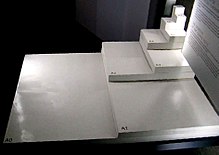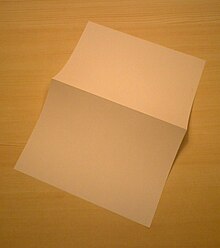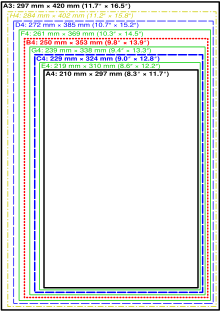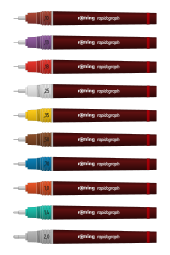ISO 216
[1] The oldest known mention of the advantages of basing a paper size on an aspect ratio ofis found in a letter written on 25 October 1786 by the German scientist Georg Christoph Lichtenberg to Johann Beckmann, both at the University of Göttingen.[2] Early variants of the formats that would become ISO paper sizes A2, A3, B3, B4, and B5 then evolved in France, where they were listed in a 1798 French law on taxation of publications (French: Loi sur le timbre (Nº 2136)) that was based in part on page sizes., referring to the argument advanced by Lichtenberg's 1786 letter, but linking this to the metric system using 1 centimetre (0.39 in) as the width of the base format.In 1921, after a long discussion and another intervention by Porstmann, the Standardisation Committee of German Industry (Normenausschuß der deutschen Industrie, or NADI in short), which is the German Institute for Standardisation (Deutsches Institut für Normung, or DIN in short) today, published German standard DI Norm 476 the specification of four series of paper formats with ratioA0 has a surface area of 1 square metre (11 sq ft) up to a rounding error, with a width of 841 millimetres (33.1 in) and height of 1,189 millimetres (46.8 in), so an actual area of 0.999949 square metres (10.76336 sq ft); A4 is recommended as standard paper size for business, administrative and government correspondence; and A6 for postcards.The DIN paper-format concept was soon introduced as a national standard in many other countries, for example, Belgium (1924), Netherlands (1925), Norway (1926), Switzerland (1929), Sweden (1930), Soviet Union (1934), Hungary (1938), Italy (1939), Finland (1942), Uruguay (1942), Argentina (1943), Brazil (1943), Spain (1947), Austria (1948), Romania (1949), Japan (1951), Denmark (1953), Czechoslovakia (1953), Israel (1954), Portugal (1954), Yugoslavia (1956), India (1957), Poland (1957), United Kingdom (1959), Venezuela (1962), New Zealand (1963), Iceland (1964), Mexico (1965), South Africa (1966), France (1967), Peru (1967), Turkey (1967), Chile (1968), Greece (1970), Zimbabwe (1970), Singapore (1970), Bangladesh (1972), Thailand (1973), Barbados (1973), Australia (1974), Ecuador (1974), Colombia (1975) and Kuwait (1975).Under ISO 536, paper's grammage is defined as a sheet's mass in grams (g) per area in square metres (unit symbol g/m2; the nonstandard abbreviation "gsm" is also used).A standard A4 sheet made from 80 g/m2 paper weighs 5 grams (0.18 oz), as it is 1⁄16 (four halvings, ignoring rounding) of an A0 page.Thus the weight, and the associated postage rate, can be approximated easily by counting the number of sheets used.ISO 216 and its related standards were first published between 1975 and 1995: Paper in the A series format has an aspect ratio of √2 (≈ 1.414, when rounded).[6][7] The geometric rationale for using the square root of 2 is to maintain the aspect ratio of each subsequent rectangle after cutting or folding an A-series sheet in half, perpendicular to the larger side.The use of the geometric mean makes each step in size: B0, A0, B1, A1, B2 ... smaller than the previous one by the same factor.A, B, and C series of paper fit together as part of a geometric progression, with ratio of successive side lengths of 8√2, though there is no size half-way between Bn and A(n − 1): A4, C4, B4, "D4", A3, ...; there is such a D-series in the Swedish extensions to the system.Colour codes are assigned to each size to facilitate easy recognition by the drafter.[4][11] The earlier DIN 6775 standard upon which ISO 9175-1 is based also specified a term and symbol for easy identification of pens and drawing templates compatible with the standard, called Micronorm, which may still be found on some technical drafting equipment.





international standardpaper sizesISO 217ISO 269aspect ratio√2:1millimetresinchesSIS 014711Square root of 2Georg Christoph LichtenbergJohann BeckmannUniversity of GöttingenFrenchthe BridgeGermanWilhelm Ostwaldmetric systemcentimetreGerman Institute for Standardisationrounding errorUnited NationsRectangularbrochurephotocopiergrammagesquare metresarithmetic divisionsq ftlettergeometrical meansgeometric progressionenvelopespaper foldingorigamisilver ratioISO 128technical penANSI/ASME Y14.1Paper densityKuhn, MarkusUniversity of CambridgeSchöne, AlbrechtInternational Organization for StandardizationrationaleISO standardsISO romanizationsIEC standards1073-11073-28501-18805/88068820-59000/90019592/95939797-110118-311941 (TR)12234-213406-215926 WIP16355-116612-216949 (TS)19775-119794-523090-323094-123094-227000 series29199-2Deutsches Institut für NormungDIN standardsDIN 1025DIN 1451DIN 1530DIN 5008DIN 5009DIN 31635DIN 41612DIN 43700DIN 4420DIN 47100DIN 62056DIN 72552DIN 91379EngschriftMunicipal Services Standards CommitteeDIN connectorMini-DIN connectorMultimedia extension connectorDIN rail